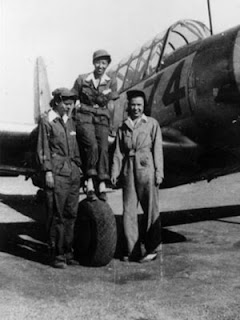The very next year, when Japanese forces began to make incursions into China, Hazel traveled all the way to China planning on volunteering for the Chinese Air Force. They turned her away because of her gender, despite their dire need for trained pilots. She stayed in China, working for a private airline. In 1937, when Japan finally invaded China, with large scale bombings, it was Hazel's ability to remain calm in a crisis that likely saved the lives of many of her friends and family, as she was able to locate a safe shelter for them during the attacks. In 1938, she escaped to Hong Kong, and then made her way to New York, where she worked for the Chinese government as a buyer to help them secure materials for their war effort.
When the US joined the war, Hazel looked for opportunities to serve, but there were few openings for women. In 1943, though, with the creation of the Women Airforce Service Pilots (WASP), she found a job that suited her perfectly. She enlisted as soon as she could, and was in the 4th class of pilots accepted and sent to Sweetwater, Texas, for training. She was then assigned to the third Ferrying Group, based out of Michigan, where the auto factories were now building aircraft for the war. Her group was tasked with flying the planes from the factory to central locations around the country where they would then be shipped to the either the European or Pacific fronts.
Hazel was well respected by her fellow service pilots as well as her superiors. She was often heard saying she'd "take and delivery anything." No risk was too much for her. During her time as a WASP, she had two forced landings -- where she had to land a plane under less than ideal circumstances -- and in both cases it was her cool demeanor that probably saved her life. In one case, she had to set the plane down in a Kansas wheat field, and then fend off an angry farmer who was convinced she was a Japanese invader.
Photo caption: WASPs being briefed in ready-room, Avenger Field, Sweetwater, Texas, May 1943. Front row, l to r: Group Commander Charles M. Sproul, Irma Cleveland, Faith Buchner, Martha Lundy, Mary Jane Stevens, Anabelle Kekic. Back row, l to r: Ruby Mullins, Hazel Ying Lee, Virginia Harris Mullins. Source: Texas Women's University.
In 1944, she was selected for a prestigious series of intensive training classes at the Pursuit School at Brownsville, Texas, where she and a handful of other women pilots who flew the faster, higher powered fighters.
I wonder what would have become of her after the war had she lived? Would she have gone on to become one of the female pilots who continued flying for either private or military projects, like WASP director Jackie Cochran? Would she have traveled the world with her husband, another Chinese-American pilot she'd met in Portland, while he served as a Chinese diplomat? Would she have been the first Asian American selected as a candidate for the Mercury 13 group of possible female astronauts? Who knows?
Even though she died young, she had already established herself as a brave young woman unafraid of taking risks and using her skills for the greater good. It's telling that the one of the first things she decided to do once she'd earned her license was to head off to a war front to serve. And for that, she's definitely a Self-Rescuing Princess Society role model.
I can't do the work of SRPS without your your support!
If you like what you read here, please share this post with your friends.
If you like what you read here, please share this post with your friends.










its awesome reading about unrelenting women...keep going sis
ReplyDelete